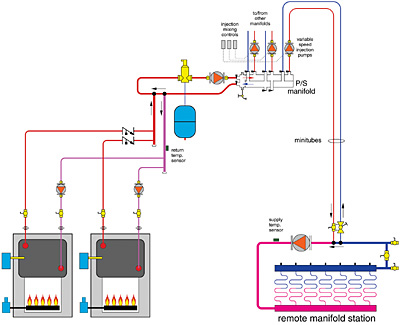Beyond Closely Spaced Tees

The wide spread acceptance of P/S piping has created market demand for products that optimize the concept while also speeding the installation. Several such products have appeared on the North American market over the last couple of years to address this demand. This month we'll look at several of them.

A Product For Parallel Primaries
Series primary loops are well suited to situations where two or more secondary loads will operate with different supply temperatures. The basic idea is pretty simple: Connect the higher-temperature loads near the beginning of the primary loop and the lower-temperature loads near the end. This arrangement tends to increase the temperature drop along the primary loop, which reduces the flow rate. It may also decrease the size of the piping and circulator for the primary loop.However, when a system has several secondary circuits that need to operate at approximately the same supply temperature, they should connect to a parallel primary loop as shown in Figure 1.

The manifold shown in Figure 2 is from Caleffi North America. It's a prefabricated means of achieving the pump isolation and equal supply temperature benefits of a parallel primary loop. A typical piping arrangement using this manifold is shown in Figure 3.

Because the openings are so close together, there is almost no pressure difference between them. Thus the pressure differential across the internal headers on the right side (from supply to return) is close to zero. The pressure increase created by a given zone circulator is almost entirely "spent" by the time the flow makes it back to the return manifold. This arrangement prevents interference between the boiler circulator and whatever zone circulators are operating. It's the same concept that keeps the peace between circulators in a typical primary/secondary system.

Figure 4 shows how this manifold could be used for a multiple-zone minitube injection system. In this application, the P/S manifold supplies several variable-speed injection pumps, one for each remote manifold station. This arrangement is possible because the extremely small pressure differential in the header will not induce injection flow in any given circuit until that circuit's injection pump is operating.
The manifold also has tappings for an air vent and drain. It provides a clever and compact alternative to traditional parallel primary loop construction.

Closely Coordinated
There are other recently released products that capitalize on the advantages of primary/secondary piping. One comes from Taco Corp. in the form of a special LoadMatch[TM] fitting as shown in Figure 5.This fitting provides the closely spaced supply and return ports for a secondary circuit. It uses a vertical baffle to split the flow path between the left and right secondary circuit ports to prevent recirculation. Because the two ports are side by side rather than one in front of the other, they are at exactly the same dynamic pressure. No flow will be induced in the secondary circuit until the secondary circulator operates.


Another product from Caleffi North America is called a "hydraulic separator," and is shown in Figure 8.
This device can be used to uncouple the pressure distribution of a typical two-pipe riser system from that of individual zone distribution circuits as shown in Figure 9. The diameter of the vertical chamber relative to that of the piping slows the vertical flow velocity.

All these devices use the same fluid mechanic principles as a pair of closely spaced conventional tees. They provide unique and timesaving ways to take advantage of those principles. Check them out for some of your upcoming projects.
Looking for a reprint of this article?
From high-res PDFs to custom plaques, order your copy today!





